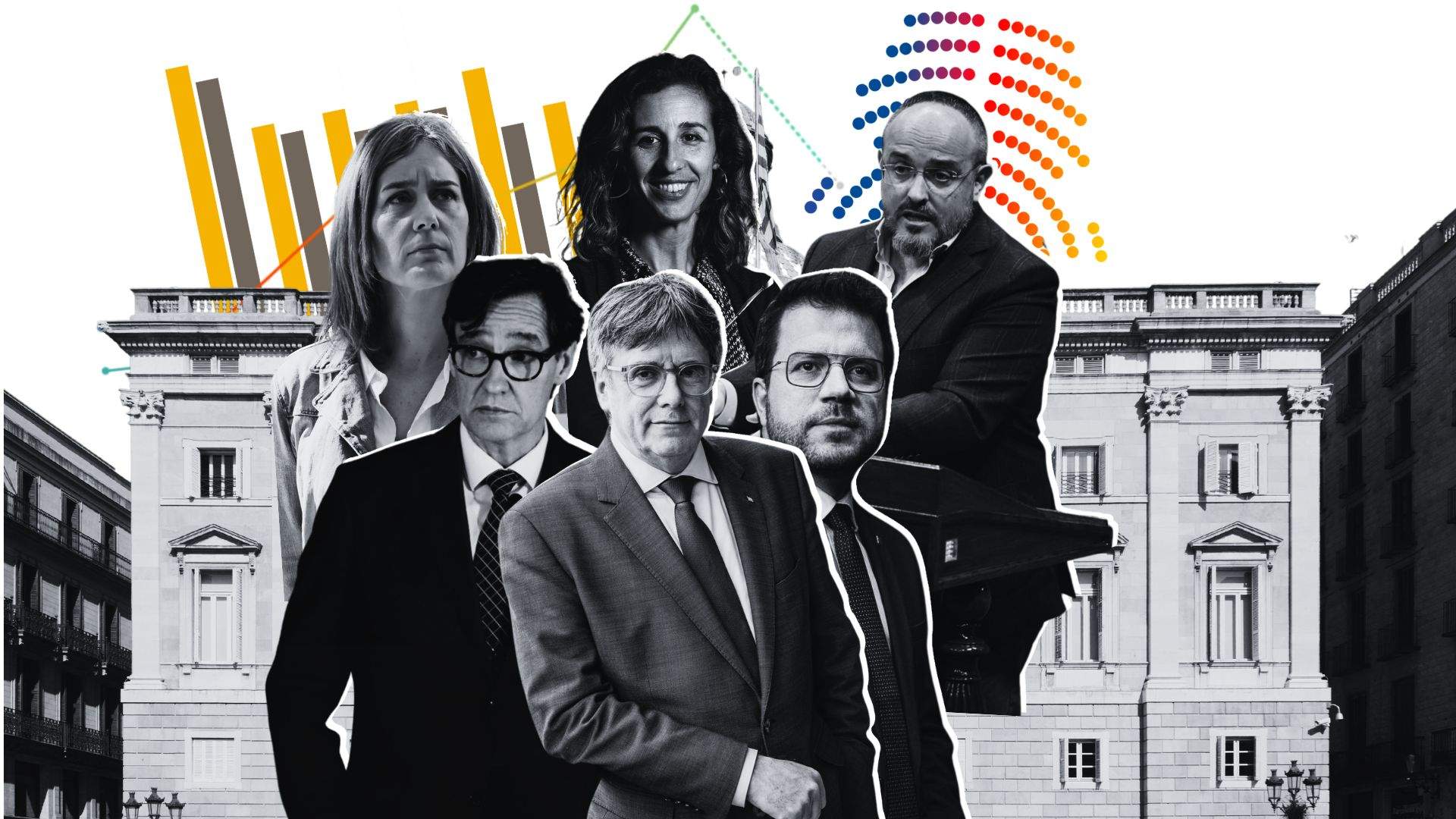The Catalan Socialist Party (PSC), with Salvador Illa as candidate for the presidency of the Generalitat of Catalonia, is set to comfortably win the 12th May election while the pro-independence candidacy of Junts+ Puigdemont for Catalonia, led by the president-in-exile, Carles Puigdemont, is expected to prevail over that of the other main independentist party, the Republican Left (ERC), headed by the current president, Pere Aragonès. Illa, however, could join with ERC and Comuns-Sumar to form a government, or with Junts. This is the projection made from the survey carried out by the Feedback Institute for El Nacional.cat on the eve of the start of the two-week election campaign in Catalonia - it starts at midnight tonight as Thursday changes to Friday. The survey was based on 700 interviews, carried out between April 19th and 24th.
🔴 Election in Catalonia 2024 | All our coverage in English
According to the survey, the PSC will repeat the first place it achieved in the last Catalan election, on February 14th, 2021, but would significantly improve its results, going from the current 33 to 39-40 seats (6-7 more) and 27.02% of votes. Junts's candidacy is expected to rise from third to second place in Parliament, with 33-36 seats, that is, it will add 1-4 further MPs to the 32 it now has, and win 21.58% of the votes. In the most favourable hypothesis, the independentists of Carles Puigdemont would have 3 seats less than the Socialists of Salvador Illa. Third place will be for ERC, which is predicted to suffer a significant decline, going from the current 33 seats to 24-27, a fall of between 9 and 6, with a total of 16.39% of votes on May 12th.
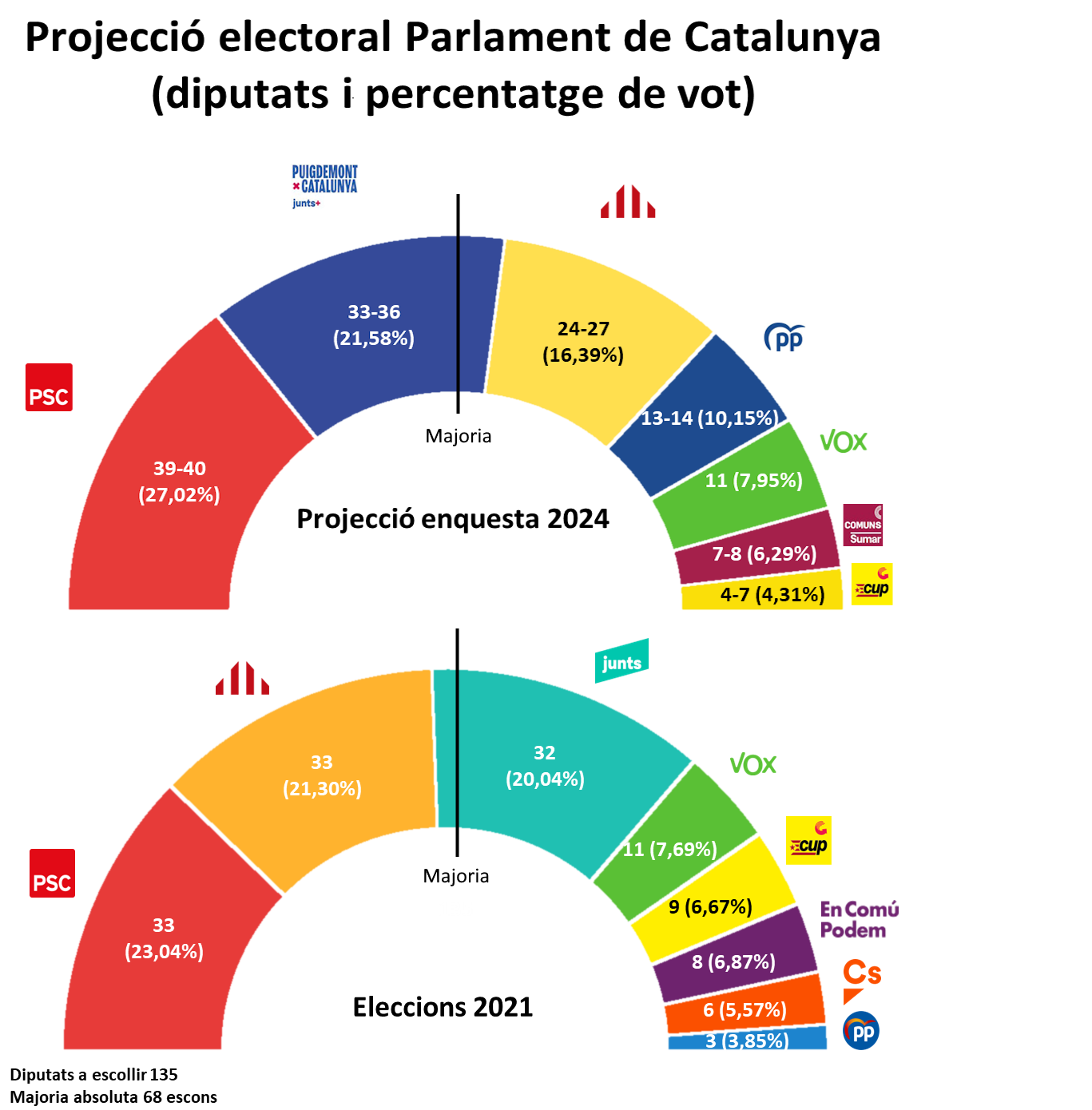
The PP's great leap
In fourth position would be the Spanish conservatives, the People's Party (PP), who surge up from the bottom of the table, according to the survey, to show the greatest increase in numbers of MPs among all the different candidacies. The list led by Alejandro Fernández leaps from its current 3 deputies to 13-14, with 10.15% of votes. The PP benefits from the disappearance of Ciudadanos (Cs) led by Carlos Carrizosa, which falls from 6 to 0 seats, taking a tiny 1.59% of the votes, as the poll predicts. On the other hand, the PP does not successfully fish in the waters of far-right Vox, led by Ignacio Garriga, which maintains the 11 seats it obtained in 2021 and collects 7.67% of the votes.
Sixth position in the Feedback poll goes to the alternative left candidacy of Comuns-Sumar, led by Jéssica Albiach, who could keep the 8 seats they have or lose one, with a margin of between 7-8 deputies and 6.29% of the votes. In seventh and last position of those entering the chamber is the pro-independence, left-wing CUP, headed by Laia Estrada, which in 2021 obtained 9 seats and would now take between 4 and 7 - a fall of 2-5 - and 4.31% of the vote. In addition to Cs falling short, neither the Islamophobic party Aliança Catalana (AC), which would collect 2.25% of the votes, nor the pro-independence list led by Clara Ponsatí, Alhora, with 1.23%, would obtain representation.
The shape of the next Catalan government
The investiture of a president and the formation of the next Catalan government will, however, once again be a particularly complex exercise in terms of the possible post-electoral pacts. According to the seat allocation predicted by the survey, Salvador Illa could aspire to lead a leftist agreement which would, however, depend on the support of ERC, in addition to the Comuns. This alliance would hold between 70 and 75 seats in Parliament, from 2-7 above the 68 needed to obtain an absolute majority in the house.
Illa could also seek a very unlikely agreement with Junts, which would in fact be the largest possible two-party total in the new Parliament, with between 72 and 76 seats out of a total of 135. Finally, there is the option of an investiture of Illa with the highly contradictory combination of the left-wing Comuns and the Spanish right-wing and far-right parties - that is, in addition to the PP, Vox would have to be part of it.
The second most plausible bloc that could be formed, after a leftist tripartite, is that of an independentist majority led by Carles Puigdemont with ERC and the CUP, although the sum is not guaranteed: at the lower end of the bracket, the three parties would have a total of only 61 seats - that is, 7 less than the absolute majority they need, while at the high end of the predictions, they would reach 70, that is to say, just 2 seats above the threshold. In the more unfavourable scenarios, the independence movement would lose the majority it obtained in 2021 - a total of 75 seats - which comfortably allowed the investiture of Pere Aragonès as president with an ERC-Junts-CUP agreement.
Barcelona
Looking at the four provincial seats over which Catalonia's proportional voting system is applied, the PSC would be the largest political force in Barcelona (which elects 85 MPs) and Tarragona (18 MPs) - where ERC would lose the first place it had in 2021 - while Junts would maintain the first position in Girona (which elects 17 MPs) and Lleida (15 MPs). In the Barcelona seat, whose 85 MPs make up the majority of the 135 seats in the Catalan chamber, the PSC would rise from 23 to 26-27 deputies, while Junts, with 18-19 (16 in 2021), would displace ERC as the second force; the Republican Left would now fall back from 19 to 15. The PP would triple its results: from 3 to between 9 and 10 deputies; Vox maintains its 7, the Comuns drop from 7 to 6 and the CUP, from 5 to 3-4. Cs lose the 5 Barcelona MPs they had.
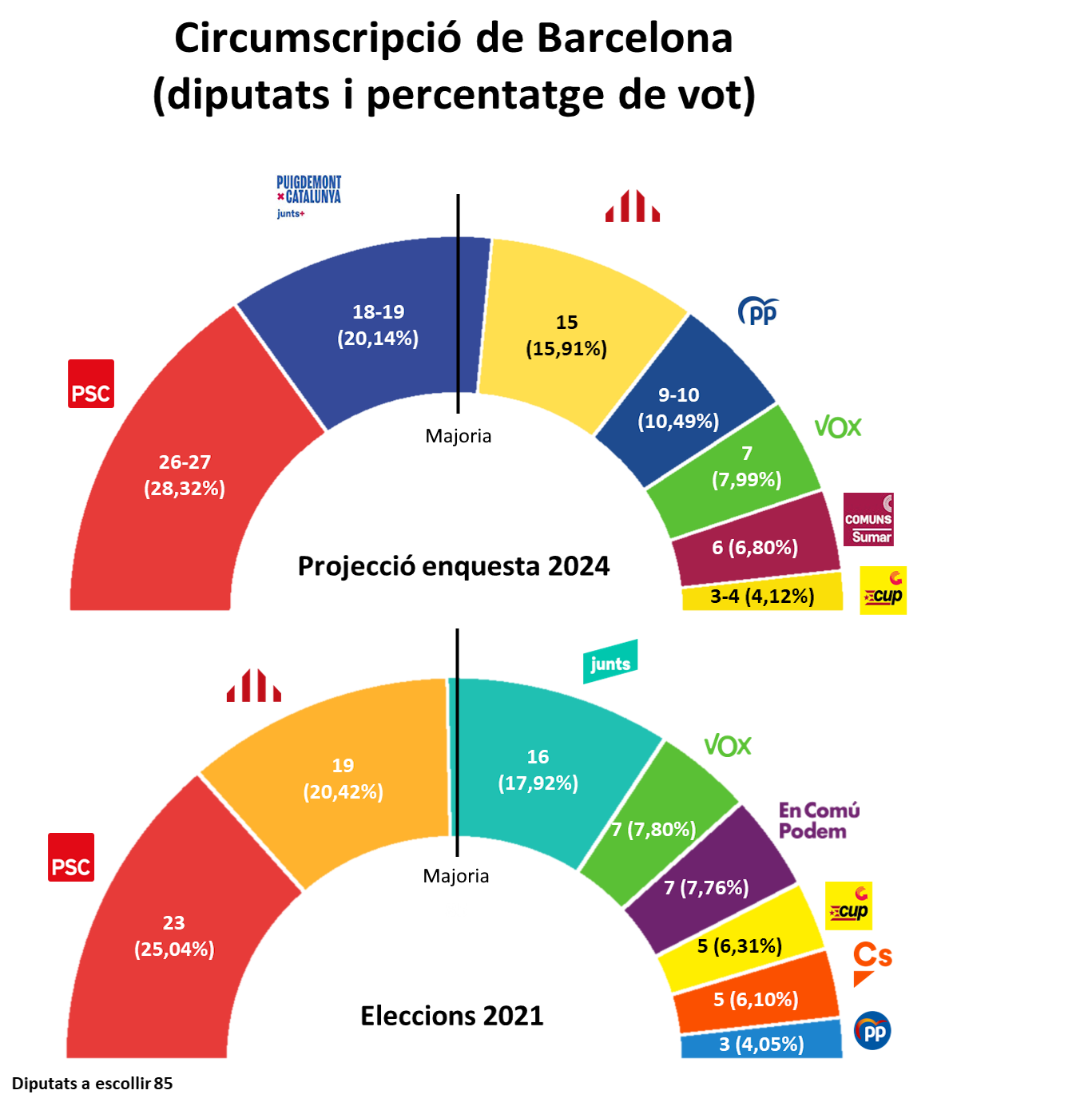
Tarragona
According to the poll, the PSC would be the largest party in the Tarragona electorate, rising from 4 to 5 seats. ERC would therefore cede the first position achieved in 2021, falling from 5 to 3-4; this gives options to Junts to come back, from the current 4 to 4-5 with the possibility of a tie with the Socialists. Vox gains 2 Tarragona seats in the poll, while the PP, which failed to win a seat in this demarcation in the previous elections, would also get 2 representatives. The Comuns would keep the only one they had; CUP (0-1) could lose theirs and Cs would definitely lose their only Tarragona seat. This electorate in the southernmost quarter of Catalonia elects 18 of the 135 members of Parliament.
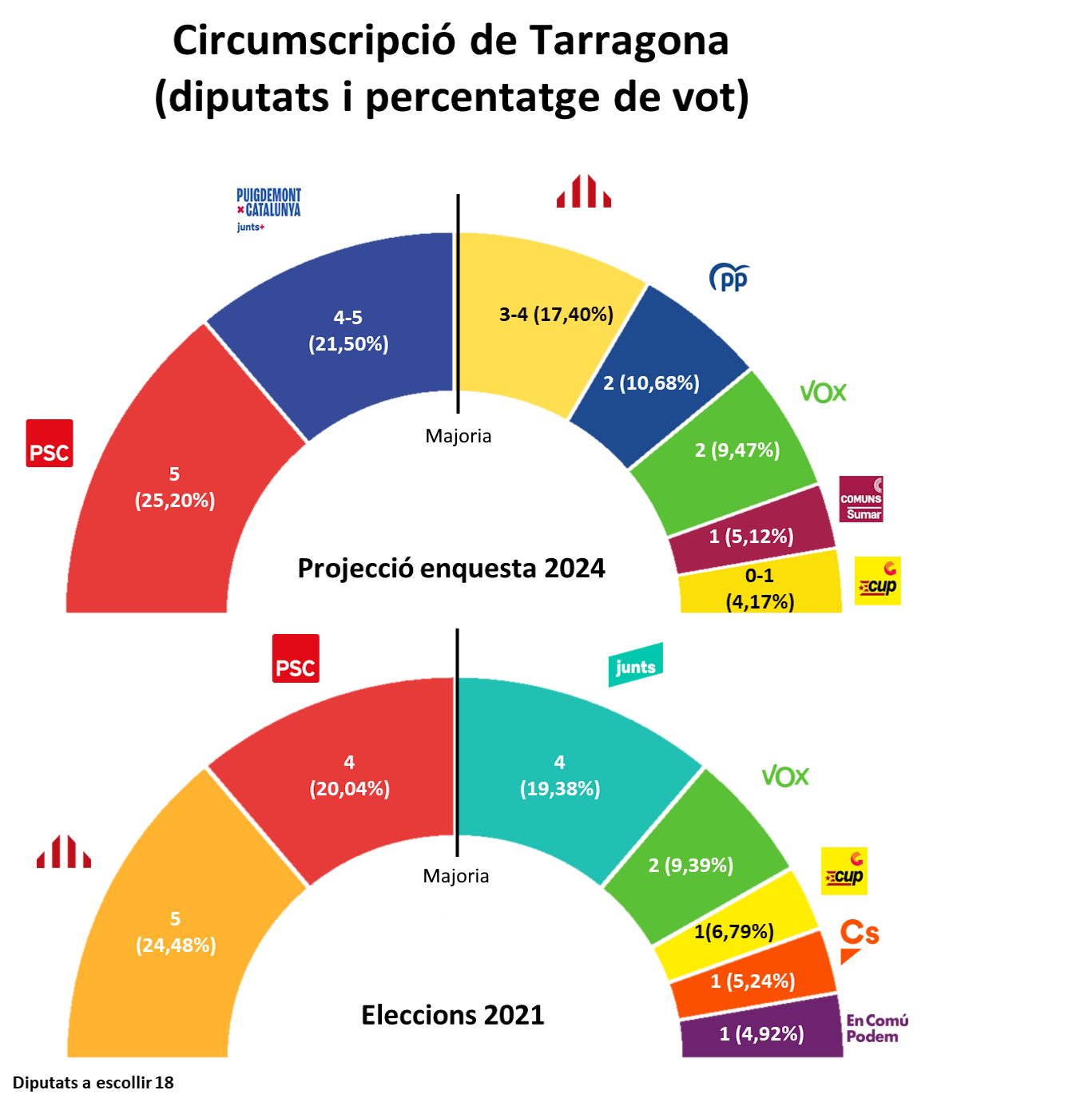
Girona
Girona, in the north-east of Catalonia, elects 17 of the Catalan chamber's 135 deputies. According to the Feedback poll, the largest party would continue to be Junts, although it would lose one seat, going from 7 to 6. The PSC, on the other hand, would add 1, rising from 3 to 4, and would thus occupy second place, which, in turn, ERC would lose by falling from 4 to 3-4 seats. The CUP would lose 1 of the 2 it has; Vox would keep its single representative; the PP (1) would return to have representation in Girona and the Comuns could also gain a seat, with the poll predicting between 0 and 1. Cs would continue without any MPs in this demarcation.
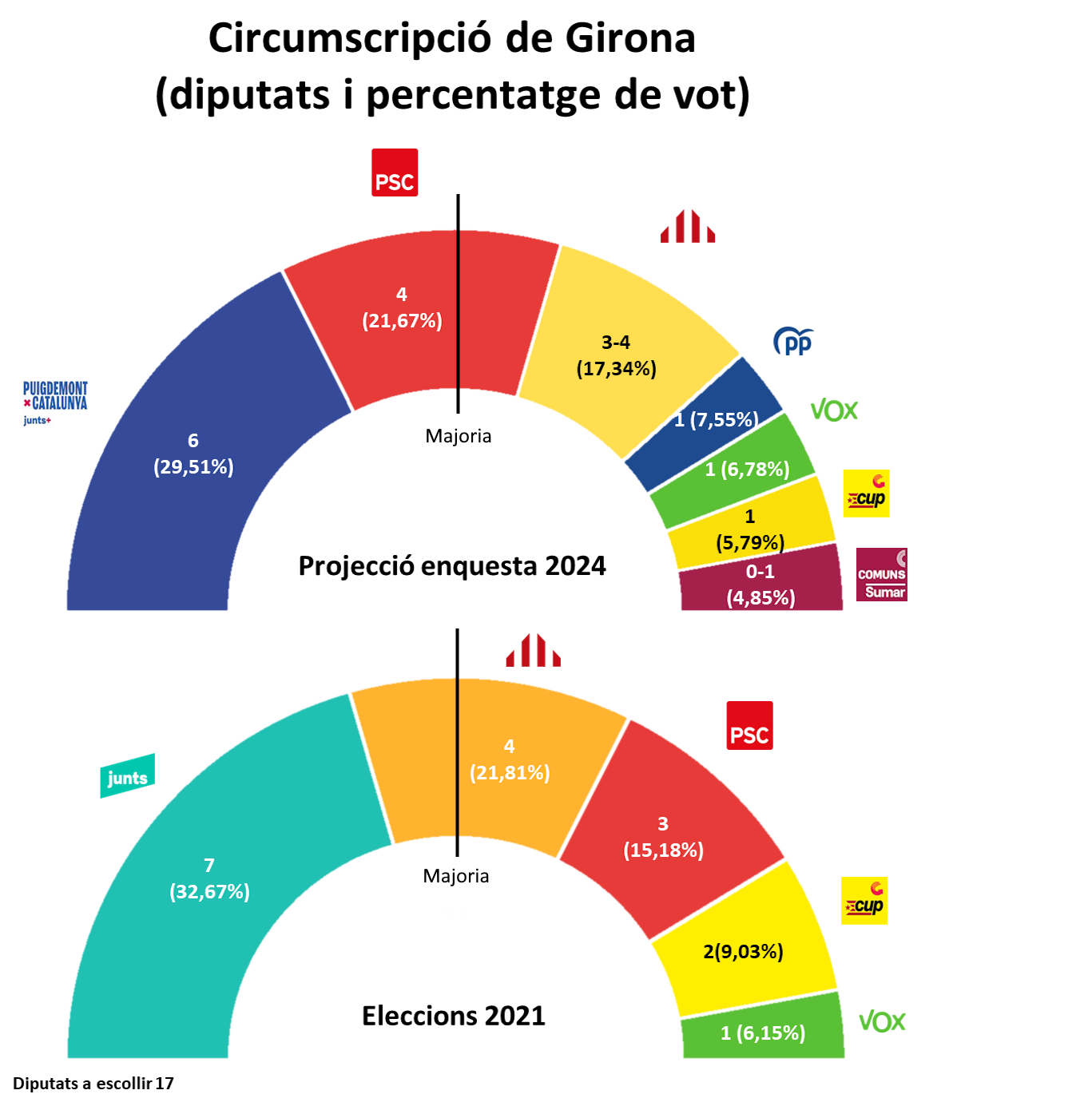
Lleida
In the Ponent - the west of Catalonia - the Lleida demarcation elects 15 seats to Parliament. Here, Junts would remain as the largest force and could improve its results in 2021, going from 5 to 5-6 seats. The PSC would be second, with 4 - one more than in 2021 - and it would displace ERC, which would drop from 5 to 3-4. VOX maintains 1 seat and the PP recovers representation in this territory with 1 deputy. The CUP could lose the single deputy it has, falling from 1 to 0-1. The Comuns and Cs would continue without a parliamentarian in Lleida.
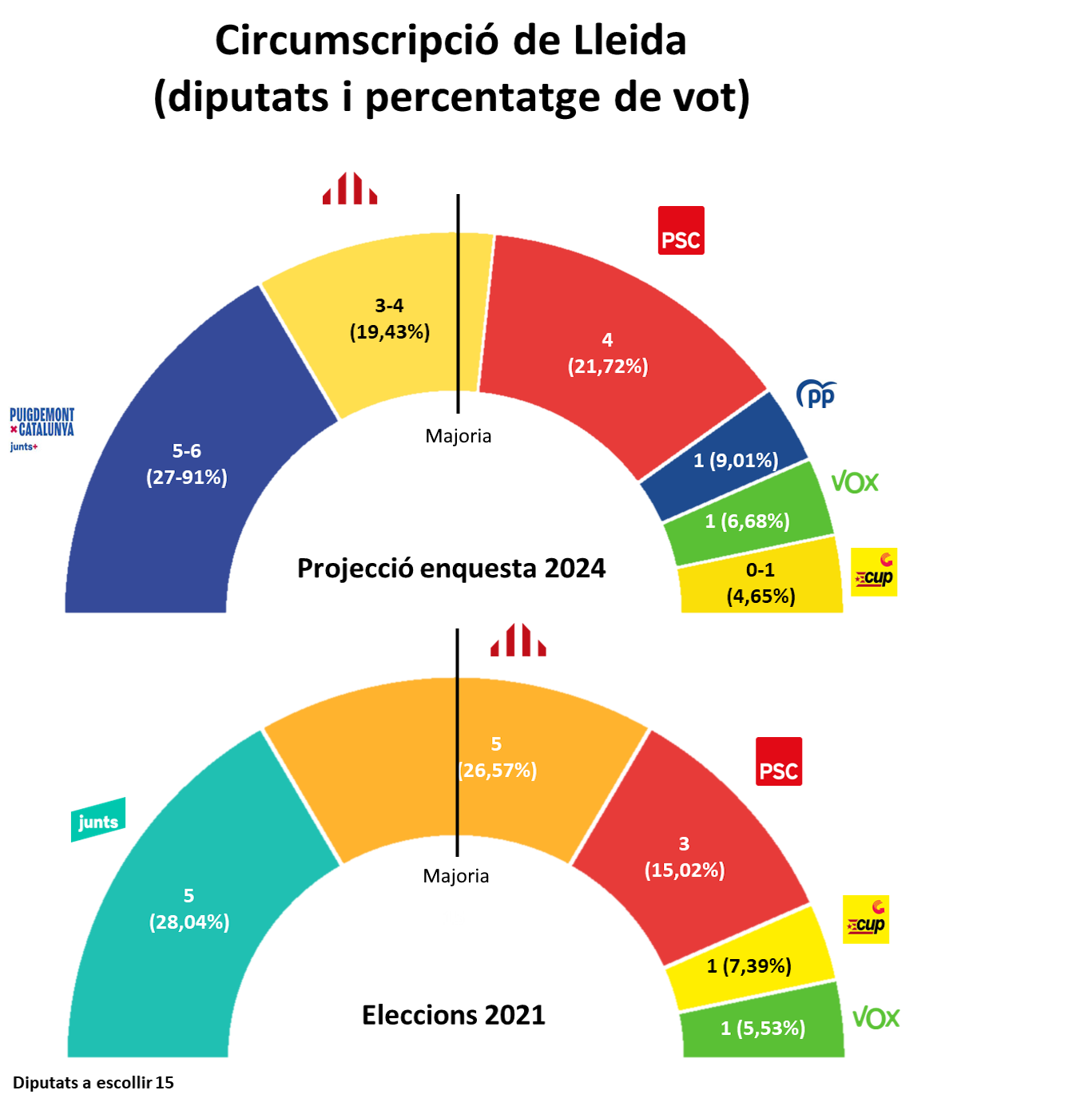
Technical details:
- Area: Catalonia
- Population: People aged 18 years and over with the right to vote in the elections to the Catalan Parliament.
- Method: Telephone survey with combination of landlines and mobile phones.
- Sample: 700 interviews.
- Quotas: Proportional on structural variables of age group and sex; with the demarcation variable used as a field work control for the selection of sampling units (cities).
- Statistical conditions: Total possible margin of error +3.78%, for an infinite population (electoral role of 5,624,067 people), with a confidence level of 95.5% (K=2), and the assumption of maximum indeterminacy where p=q=50/50.
- Field work: Survey interviews conducted between Friday 19th and Wednesday 24th April 2024.

